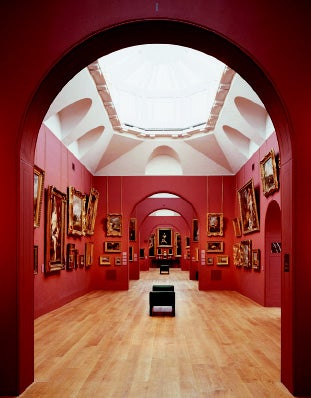Masterpieces of European Painting from Dulwich Picture Gallery
March 9 through May 30, 2010
History of Dulwich Picture Gallery
| |
 |
|
|
| |
Interior view, Dulwich Picture Gallery, London |
|
|
Five miles southeast of central London, Dulwich Picture Gallery is England’s oldest public art gallery. It was founded in 1811 — more than a decade before London’s National Gallery came into existence — to accommodate the bequest of 370 paintings left to the boys’ school Dulwich College by the landscape painter and art dealer Sir Peter Francis Bourgeois (1753–1811). In 1790 Bourgeois and his French partner, Noel Desenfans (1744–1807), had been charged with creating a collection of Old Master paintings for King Stanisław Augustus of Poland. The dealers were able to take advantage of the supply of Old Masters that appeared on the market after the upheavals of the French Revolution, and they purchased masterpieces by Reni, Rubens, Poussin, Van Dyck, Rembrandt, Murillo, and Watteau. When King Stanisław was deposed five years later and his kingdom partitioned among Russia, Prussia, and Austria, the London dealers found themselves with an impressive inventory on their hands, the nucleus of a national collection.
It was Sir Peter Francis Bourgeois who, in casting around for a public institution that might provide a home for this collection, settled on the boys’ school south of the Thames that had been founded in the early seventeenth century by Elizabeth I’s favorite actor, Edward Alleyn. After Bourgeois’s untimely death in January 1811 from a riding accident, it was left to Noel Desenfans’s widow, née Margaret Morris (1731–1813), to carry out Bourgeois’s bequest to Dulwich College. Morris lost no time in ensuring that the collection would be housed in an appropriate building. In January 1811 she commissioned the architect Sir John Soane (1753–1837) to design a purpose-built gallery on the grounds of the school, with five rooms illuminated by natural light through skylights. The collection was transferred to Soane’s building in 1814, after Margaret’s death. The new Dulwich Picture Gallery opened its doors to students from the Royal Academy in 1815 and to the general public two years later. Its core collection has been augmented by two notable bequests of British paintings—a group of peerless Gainsboroughs in 1837 and some fifty works, mainly portraits, donated by the connoisseur, dealer, and Pre-Raphaelite painter Charles Fairfax Murray (1849–1919) in 1911. The Gallery’s collection continues to grow, and in 2000 Soane’s building was renovated and received an elegant extension.

Exterior view, Dulwich Picture Gallery, London

Colin B. Bailey, Associate Director and Peter Jay Sharp Chief Curator at the Frick, interviews Xavier F. Salomon, Arturo and Holly Melosi Chief Curator at Dulwich, in this interesting podcast in which they discuss the history of Dulwich Picture Gallery and the origins of the exhibition at The Frick Collection.
Download MP3
The exhibition, in the Frick’s Oval Room and Garden Court, is co-organized by Colin B. Bailey, Associate Director and Peter Jay Sharp Chief Curator at the Frick, and Xavier F. Salomon, Arturo and Holly Melosi Chief Curator at Dulwich. A fully illustrated catalogue, written by Dr. Salomon, features an essay on the origins of the collection at Dulwich as well as comprehensive entries on the nine works.
Principal funding for the exhibition is provided by Christie's and Melvin R. Seiden.
Additional support is generously provided by John and Constance Birkelund, Mr. and Mrs. Walter A. Eberstadt, Fiduciary Trust Company International, Barbara G. Fleischman, Francis Finlay, and Hester Diamond.
The accompanying catalogue is made possible by Jon and Barbara Landau.
This exhibition is supported by an indemnity from the Federal Council on the Arts and the Humanities. |


